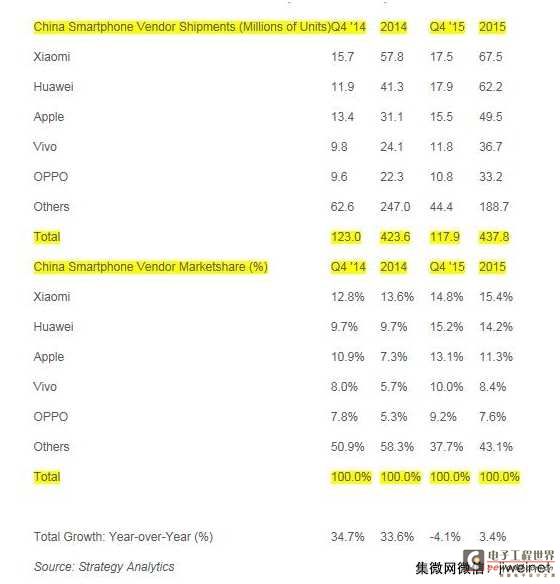"The mobile phone industry is not the Red Sea, but the blood sea." Zhou Hongyi's statement may be the most appropriate description for the 2015 Chinese smartphone market.
However, the 2015 mobile phone circle is like a siege, some people want to enter, and some people have to quit. In this year, the home appliance company Gree, Internet company LeTV 360, even comic actor Wang Zijian and English teacher Li Yang have joined the army of mobile phone industry; but this year, big cola, Amoi, Tianyu and other mobile phone manufacturers On the verge of bankruptcy, Fuchang Electronics, Zhongtianxin and other foundries went bankrupt.
2015: Ice and fire under the price war
In 2015, China's smart phone market entered the stock market from the incremental market. Coupled with the fierce price war, the domestic manufacturers were polarized and the market concentration was greatly enhanced.

Figure: Strategic Analytics China's 2015 smartphone market situation announced by Strategy Analytics
According to the Strategy Analytics report, China's smartphone market shipments in 2015 were 437.8 million units, up 3.3% year-on-year. Compared with the rapid growth in previous years, the growth of China's smartphone market is increasingly limited. The total share of the top five companies of Xiaomi, Huawei, Apple, OPPO and vivo has reached 56.9%, which undoubtedly further squeezes the living space of other SMEs.
The market is limited in increments. Large manufacturers have to fight for price wars in order to reduce costs and reduce profits. The pressure on the entire industry chain can be imagined; while small manufacturers have no capital strength and no bargaining power in the industry chain. It can only be consumed in a price war. Under such market conditions, the closure of many small manufacturers and foundries can not be avoided.
However, behind the glamorous shipment data, the days of big manufacturers are not good. The domestic smartphone shipments are mainly concentrated in the low-end products. Although the growth is fast, they are really profitable, but the smartphone industry Profits are almost always controlled by companies such as Apple and Samsung. According to the statistics of the Ministry of Industry and Information Technology, the average profit margin of China's mobile phone industry in 2014 was only 3.2%, which was lower than the average level of electronic manufacturing by 1.7 percentage points. In 2015, the mobile phone industry is still at a low profit level.
2016: Comprehensive changes in markets, brands, channels, etc.
The tragic 2015 has gone far, and various domestic mobile phone manufacturers have also announced their shipments or sales data last year. Under such market conditions and performance, some people are happy. Huawei has grown rapidly, and global shipments of smart phones have exceeded 100 million. Xiaomi faces the ceiling and failed to complete the target for this year; Lenovo's domestic market is still tepid; OPPO and vivo are screaming and making a fortune. So in 2016, how will domestic mobile phone manufacturers play? From the various strategies and goals announced this year, we can roughly sort out some directions.
First, there are a lot of emerging markets such as India and Southeast Asia.
Although the Chinese smartphone market has peaked, emerging smartphone markets such as India, Southeast Asia and Africa are on the eve of the outbreak. India is currently the world's third-largest smartphone market, but smartphone penetration is relatively low, with only 110 million to 120 million people using smartphones in the 1.25 billion population. IDC predicts that Indian smartphone sales will surpass the US as the world's second-largest smartphone market next year. Under the huge market increase, Huawei, Lenovo, Xiaomi, Jinli, Vivo, LeTV, Meizu, etc. have entered India and hope to share a piece of cake. According to Indian media reports, the market share of Chinese smartphone brands in India has been from a few years ago. 4% to 5% has grown to 20%, ranking third after India and South Korean brands. This year, I believe that more domestic brands will enter and force emerging markets such as India and Southeast Asia.
In addition to emerging markets, the European and American markets are also the goal that domestic brands have always wanted to expand, but they suffer from patent barriers. At present, ZTE Huawei has a strong patent accumulation. The domestic brands in Europe and America are also based on ZTE Huawei. After the acquisition of motorcycles, Lenovo solved the patent problem in the European and American markets, but Lenovo still has to work in the European and American markets, according to Lenovo. The third-quarter earnings report showed that Lenovo’s total sales of smartphones reached 2020 million units in the third quarter, with the proportion of total sales outside China rising from 75% in the previous quarter to 83%, but the growth was mainly in India and Emerging markets such as Indonesia are dominant. For domestic brands such as Xiaomi, Meizu, OPPO and vivo, which are relatively weak in patent accumulation, I am afraid it is difficult to get involved in the European and American markets in the short term.
Second, cultivate the brand to force the mid-to-high-end market
The price war in 2015 has caused domestic manufacturers to fall into the quagmire of price changes.
In order to complete the shipment target of 80 million units, Xiaomi launched a series of low-end products such as red rice 2, red rice 2a, millet 4c, red rice note3, etc., but the shipment volume still only reached 70 million units, so that Lei Jun announced In 2016, Xiaomi is going to KPI and happy.
Meizu launched low-end products such as Charm Blue 2, Charm Blue Note 2, Charm Blue Metal, etc. The total sales volume exceeded 20 million units, an increase of 350% over last year, but the sales of Charm Blue series accounted for more than 50%. At the annual meeting, Mei Zhang, founder of Meizu Technology, also pointed out that in 2016, "stable growth, profit creation, and advancement into IPO" will be achieved.
Although Xiaomi and Meizu have also launched mid-to-high-end products such as Xiaomi Note and Meizu PRO 5, the sales volume is actually very bleak.
Huawei is relatively different in strategy. "Preempting high-end and surpassing Apple" has always been emphasized by Huawei's BG CEO Yu Chengdong. According to Huawei's data, Huawei's consumer business sales in the third quarter of 2015 were at 2,000 yuan. The shipments of medium and high-end smartphones above RMB were increased to 33%.
Canalys' data shows that Huawei's average selling price per smartphone rose from $216 in 2014 to $306 in 2015, while the average selling price of Xiaomi smartphones dropped from $189 to $149. At the same time, the average selling price of mobile phones in the Chinese market in 2015 also rose from $260 a year ago to $319. After the fierce price war in 2015, the domestic manufacturers in 2016 are the time to cultivate the brand and force the mid-to-high-end market.
Third, online saturation return line
Xiaomi, which has caught up with the barbaric growth opportunities of Chinese smartphones, has expanded at the initial stage of its establishment. It has been the top spot in the Chinese smartphone market in three years. Its pioneering Internet mobile phone model has also been followed up by many domestic manufacturers, but As the growth rate of China's smartphone market slows down, online channels have also entered a stagflation stage. According to Sino data, since March 2015, online mobile phone sales have been declining at an average rate of 5% per month. Sales in the offline mobile phone market increased by an average of 6%-8% per month. In particular, OPPO and vivo rely on the offline layout of third- and fourth-tier cities. In 2015, mobile phone sales reached 50 million units and 40 million units respectively, which made it difficult for many manufacturers to look back.
According to an internal document obtained by Reuters, in order to increase sales of mobile phones, Xiaomi will strengthen its offline sales channels this year, and plans to sell 58 million smartphones in China through retail channels such as Suning and Gome. "The number of retail stores has increased from 20 to 50.
He Gang, president of Huawei's mobile phone product line, previously announced that Huawei will implement the "Thousand County Plan" in 2016, and will build a physical store covering 1,000 counties and cities, and arrange offline channels at the county level. Yang Yuanqing, chairman and CEO of Lenovo, has repeatedly stressed to the outside world that Lenovo’s mobile phone will mainly seek growth in the retail and carrier markets, rather than the online market. This is inconsistent with ZTE’s strategic plan for 2016.
Fourth, pay more attention to technology and patents
Technology and patents are not only the basis for the transformation of domestic and high-end markets, but also the necessary conditions for overseas markets.
In order to get rid of the control of CPU manufacturers such as Qualcomm and MediaTek in the supply chain, domestic smart phone manufacturers have developed their own CPUs. According to data released by Huawei, as of November 2015, the shipment of Hess Kirin has exceeded 50 million. Its latest flagship Mate 8 is also built with its own Kirin 950; Xiaomi will also cooperate with Lianxin Technology to launch its own processor. It is expected to be available early next year; at the end of 2015, ZTE will also announce the launch of ZTE OS and Xunlong core, and Xunlong core is expected to be applied to ZTE's main model as soon as next year. For mobile phone manufacturers, independent research and development processors can get rid of the control of the industrial chain on the one hand, and on the other hand, one of the ways to expand the source of profits.

Figure: In the top ten patents granted by enterprises in 2015, ZTE Huawei has always been in a dominant position among domestic manufacturers. According to the data released by the State Intellectual Property Office, among the top ten corporate invention patents in 2015, ZTE and ZTE Huawei ranked second and third with 2,673 and 2,413, respectively.

Figure: Top 10 applications for corporate invention patents in 2015
Among the top ten applications for invention patents, ZTE ranked third with 3,516, and OPPO 3,338, Huawei 3,216, Xiaomi, 3,183, Qihoo 360, 2,777, and Lenovo, 1,826. This also shows that domestic manufacturers are paying more and more attention to patents.
V. Integration and vertical integration
In 2015, the mobile phone circle, of course, must also be in the process of mergers and acquisitions and layoffs.
Meizu has already invested in Ali, and Hammer and Nubia have also accepted Suning's investment. At the same time, 360, Cool and LeTV have staged a love triangle. Among them, Amoi, Tianyu and many other small manufacturers closed down, and one of the 45 offline offline experience stores was closed. Even the distributors were merged into OPPO into subsidiaries. Meizu also announced layoffs of 5% at the beginning of this year.
So what about 2016? I am afraid that the nightmare of layoffs and bankruptcies will not go away.
VOZOL D6 Vape are so convenient, portable, and small volume, you just need to take them
out of your pocket and take a puff, feel the cloud of smoke, and the fragrance of fruit surrounding you. It's so great.
We are China leading manufacturer and supplier of Disposable Vapes puff bars, vozol d6 disposable vape,vozol d6 vape kit,
vozol d6 vape pen, and e-cigarette kit, and we specialize in disposable vapes, e-cigarette vape pens, e-cigarette kits, etc.
vozol d6 disposable vape,vozol d6 vape kit,vozol d6 vape pen,vozol d6 vape 1000 puffs,vozol d6 e-cigarette 1000 puffs
Ningbo Autrends International Trade Co.,Ltd. , https://www.mosvapor.com
